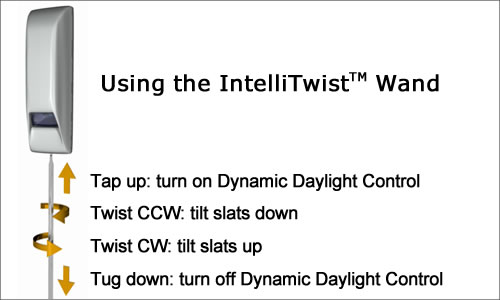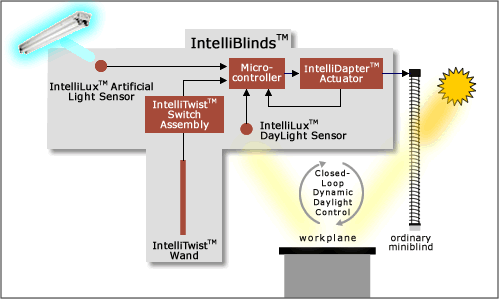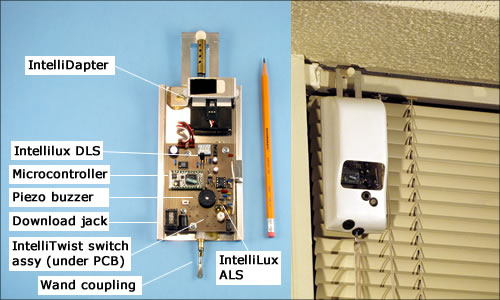Description
Instantly Automates any Minblind
The IntelliBlinds™ Model D is an inexpensive device that replaces the tilt-control wand of any ordinary wand-actuated miniblind, instantly converting it into a state-of-the-art automated shading system. It can be installed in minutes without tools and without need to modify (or even remove) the host blind.
Like some other miniblind automation devices, IntelliBlinds™ uses a microcontroller-actuated electric motor to tilt the slats of its host blind in response to changing conditions. What makes IntelliBlinds™ unique are its innovative sensors, user interface, automation algorithms, and electromechanical design—all of which are protected by in-force and in-process U.S. utility patents. This synergistic combination of innovations makes IntelliBlinds™ smarter and easier to use than conventional automated shading systems, regardless of cost—and much less expensive, too.
Why Miniblinds?
Many of the innovations that make IntelliBlinds™ so cost-effective can also be applied to other types of adjustable window coverings, as well as to electronically controlled smart glazings. But we chose ordinary miniblinds as the first application for the technology, for two reasons:
- The wand-actuated miniblind is arguably the most cost-effective shading device ever developed, and is available in a wide variety of styles, sizes, and colors at very low cost.
- There are over 500 million wand-actuated miniblinds already installed in U.S. buildings, many of them with decades of useful life left. By leverging the sunk investment in installed miniblinds, IntelliBlinds™ can give each of those 500 million windows a state-of-the-art automated shading capability at very low incremental cost. And even if a new blind must be purchased, the total cost is still far lower than that of conventional automated shading products.
So IntelliBlinds™ relies on an ordinary miniblind to perform the shading function, while focusing exclusively on the automation function. That reduces risk, facilitates manufacturing and distribution, and maximizes cost-effectiveness.
Operated with Just a Single Intuitive Control
The IntelliBlinds™ Model D doesn't need to be programmed with a shading schedule or a set of shading rules, and it doesn't need buttons, switches, or displays. Instead, it needs just one control: the IntelliTwist™ wand. Users operate IntelliBlinds™ exactly as they'd operate an ordinary miniblind—by twisting the wand to tilt the slats as desired.

Automatically Adjusts Shading to Preferred Settings
Like some other automated shading systems, The IntelliBlinds™ Model D automatically adjusts the shading to users' preferred settings whenever there are significant changes in the interior or exterior environment.
But unlike conventional automated shading systems, IntelliBlinds™ doesn't need to be programmed with those preferred settings. If it doesn't already know the preferred setting for the new conditions, it doesn't make a shading adjustment on its own; instead, it waits for users to adjust the shading as desired by twisting the IntelliTwist™ Wand.
After each wand twist, IntelliBlinds™ learns something about the users' shading preferences by correlating the new shading setting and interior daylight level with recent changes in the interior and exterior environment. Thereafter, IntelliBlinds™ automatically adjusts the blind to either the same setting—or to provide the same interior daylight level, depending on the conditions—when it recognizes the same pattern of changes.
Within just a few days of installation, IntelliBlinds™ becomes smart enough to always know when and how to adjust the shading on its own, virtually eliminating the need for future manual adjustments.
Performs Dynamic Daylight Control (DDC)
In addition to automatically providing preferred shading settings, the IntelliBlinds™ Model D can do something that only the most complex automated shading systems can do: it can dynamically regulate the interior daylight level, automatically adjusting the shading to compensate for changes in weather and movement of the sun. Because so few automated shading systems offer this capability, there isn't an accepted term for it; we call it Dynamic Daylight Control (DDC).
When compared to manually adjusted blinds and shades, DDC triples the median level of useful, glare-free daylight. That makes it key to exploiting the full energy saving potential of today's daylight-harvesting lighting controls. Unfortunately, conventional DDC systems are far too expensive to be cost-effective for mainstream use.
IntelliBlinds™ isn't just capable of DDC—it does it better than the most sophisticated conventional systems, and at only one-third the cost. In fact, the IntelliBlinds™ Model D is the first DDC-capable device that's truly cost-effective for retrofit daylight-harvesting applications, offering a typical payback period of just a few years.
IntelliBlinds™ automatically engages DDC whenever it senses that energy could be saved through daylighting, i.e. during daytime whenever the room lights are "on". When DDC is engaged, IntelliBlinds™ automatically adjusts the shading to maintain the users's preferred interior daylight level despite large fluctuations in the exterior daylight level, e.g. due to changes in weather, the passage of clouds, or movement of the sun. And the user can adjust the daylight set-point at any time by twisting the IntelliTwist™ Wand.
Works 24-7
The IntelliBlinds™ Model D isn't active just during daytime—it works around the clock, whether or not the area it's installed in is occupied.
When the area is unoccupied, IntelliBlinds™ (by default) tilts the slats of its host blind to minimize the energy consumed by the building's HVAC system. When the area is occupied, IntelliBlinds™ behaves according to what it has learned about the user's shading preferences. In a non-residential (e.g. office) building, the resulting pattern of automated shading adjustments is typically very simple, as illustrated by this example:
- When the sun rises and the room is unoccupied, IntelliBlinds™ closes the slats in summer and opens the slats in winter to minimize loads on the building's HVAC system
- When the room is occupied at or after sunrise, IntelliBlinds™ engages DDC operation: it keeps the slats as open as possible without risk of glare
- When the sun sets and the room is occupied, IntelliBlinds™ closes the slats to maximize privacy
- When the room is unoccupied after sunset, IntelliBlinds™ opens the slats in summer and closes the slats in winter to minimize loads on the building's HVAC system
In residential buildings, however, the pattern of automated adjustments made by IntelliBlinds™ is typically more complex, often requiring dozens of "when-then" rules to describe. IntelliBlinds™ is smart enough to learn how to make these adjustments on its own—without any need for deliberate programming or set-up by the user.
Simple, Inexpensive Design
The innovations that make the IntelliBinds™ Model D so smart also make it extremely simple, both electronically and physically.
Electronically, IntelliBlinds™ is a microcontroller-based servopositioning system that rotates its output shaft in response to signals from four switches and two built-in sensors:

An interior view of the latest prototype can't yet be shown publicly because some of its features are the subject of in-process patent applications, but the simplicity of the basic design is evident in even the earliest prototype:

Even the first-generation prototype has a very low component count (requiring only a single-sided PCB with less than 6 square inches of board area—even with through-hole components). Of course, the current prototype and reference production designs are even smaller and simpler.
Costs Two-Thirds Less than DDC Systems Based on Conventional Technology
The simplicity of IntelliBlinds™ drastically reduces the cost of state-of-the-art automated shading. As previously noted, the most sophisticated form of automated shading is Dynamic Daylight Control (DDC), and the IntelliBlinds™ Model D slashes the cost of DDC by two-thirds relative to conventional techology:

These cost savings help make the IntelliBlinds™ Model D the first and only DDC technology that's commercially viable for retrofit daylighting applications in existing buildings..
Based on PatentedTechnology
The unprecedented functionality, simplicity and affordability of the IntelliBlinds™ Model D is due to innovations in virtually every aspect of its design—all of which are either patented, patent-pending, or subjects of in-process patent applications:
- IntelliLux™ ALS. The IntelliLux™ Artificial Light Sensor (ALS) senses the level of artificial light in the room while ignoring any daylight. This enables IntelliBlinds™ to adapt its behavior to that of the lighting system without need for any wired or wireless connections, and ensures that IntelliBlind is compatible with all lighting systems, regardless of design.
- IntelliLux™ DLS. The IntelliLux™ DayLight Sensor (DLS) senses the level of daylight in the room while ignoring any artificial light. This enables IntelliBlinds™ to perform true closed-loop Dynamic Daylight Control (DDC) using a simple algorithm, eliminating the need for a conventional remote daylight sensor, solar angle-of-incidence sensor, slat-tilt sensor, or complicated commissioning process.
- IntelliState™ Automation. IntelliState™ Automation is an algorithm that learns—and then automatically provides—users' preferred shading settings under various conditions. IntelliState™ works by correlating users' deliberate shading adjustments with the recent history of information from the IntelliLux™ sensors.
- IntelliTwist™ USI. The IntelliTwist™ User-System Interface (USI) includes the IntelliTwist™ Wand and a set of system commands that take full advantage of IntelliState™ Automation's learning capability. The IntelliTwist™ USI eliminates the need for remote switches, keypads, or displays, and allows all of the IntelliBlinds™ functions to be accessed via intuitive movements of the Wand.
- IntelliDapter™ Motorization. The IntelliDapter™ incorporates a floating motor mount that makes IntelliBlinds™ compatible with any wand-actuated miniblind, regardless of size or design—and allows it to be installed without need to modify or even remove the host blind.
Summary of Key Points
- The IntelliBlinds™ miniblind actuator is an inexpensive module that instantly automates any of the over 500 million wand-actuated miniblinds already installed in U.S. buildings
- IntelliBlinds™ does more than conventional automated shading devices, yet costs less and is far easier to use:
- IntelliBlinds™ doesn't need to be deliberately programmed. Instead, it learns users' shading preferences on its own, thereafter automatically adjusting the shading to the correct settings as conditions change
- That, in turn, eliminates the need for a complex and expensive user interface: IntelliBlinds™ can be operated with just a single intuitive control—the IntelliTwist™ Wand
- The IntelliBlinds™ Model D can do something that was previously possible at three times the cost: it automatically performs Dynamic Daylight Control (DDC) when it senses that energy could be saved through daylight harvesting, self-adjusting to maintain the desired level of glare-free daylight despite changes in weather or the position of the sun
- Due to its DDC capability and low cost, the IntelliBlinds™ Model D is the first and only automated shading device that's cost-effective for mainstream daylighting applications
- IntelliBlinds™ is covered by more than a half-dozen in-force, pending, or in-process utility patents

